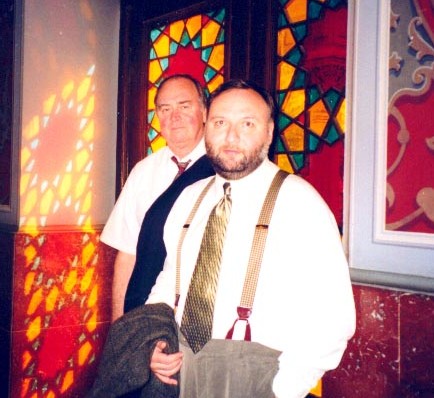

McMahonMed
Viruses Called Bacteriophages Resurface As Viable Option To Fight Infections
The idea of using one microbe to kill another is attributed to the scientist Felix d'Herelle. In 1910, he observed that bacteria in the stool of sick locusts, which he had collected for analysis, seemed to disappear as if by magic. The same thing happened seven years later, when he was working with stool specimens from patients with bacterial dysentery. In each case, the disappearance appeared to be connected with clear, round spots on a lawn of bacteria on a laboratory dish. He figured that something in that dish was causing the bacteria to disappear.
After d'Herelle discovered that he had found beneficial viruses that could overcome bacterial illnesses, he and many others around the world used them freely. Although no harm was reported from their use, they were not endorsed in the United States because no scientific controls had been conducted. Despite that, bacteriophages, as d'Herelle called them, after the Greek word phagein, "to eat," were viewed as a viable concept in the 1930s, when they were listed by Eli Lilly & Co. as one of its biological therapies.
In the 1940s, bacteriophage therapy dwindled in popularity, because its results were not consistent. Moreover, the arrival of antibiotics seemed to make bacteriophage therapy unnecessary, although it continued to be used in other parts of the world.
Fast-forward to more recent times: Carl Merril, MD, Chief of a Biochemical Genetics Laboratory at the National Institutes of Health (NIH), Bethesda, Md., told Pharmacy Practice News that one reason bacteriophage therapy did not always work was because the viruses were removed too quickly by the filtering organs of the reticuloendothelial systemthe liver and spleen. Publishing this theory and supporting observations (Nature 1973;246:221-222), Dr. Merril suggested that flooding the system with colloidal particles might be the answer. The piece was put aside and the idea forgotten until about five years ago, when he became fully aware of the threat from antibiotic-resistant bacteria. "Then I realized, thinking back to the article, that we could make or find mutant viruses that would stay in the bloodstream long enough to kill off the bacteria," he said. He and Richard Carlton, MD, established a cooperative effort to make such long-circulating viruses and to test their capacity to rescue animals infected with bacteria.
Dr. Carlton was astonished at first to learn that bacteriophages, or "phages" for short, were used as a form of antibacterial therapy. Now, as President and CEO of Exponential Biotherapies, Port Washington, New York, he ticks off their talents. "All the phages want to do is kill bacteria," he said. "When a phage finds the receptor on a bacterium, it pierces it and injects DNA. That triggers a multiplication chain: As many as 40,000 clonescalled daughtersof the attacking virus can be produced in one hour." This is the tremendous potential of phage therapy that excited the imagination of the public in the 1920s and 1930s, Dr. Carlton said. "You can create so many phages at the expense of the bacteria."
To solve the rapid-clearance problem, Dr. Merril and Dr. Carlton have developed a "serial passage" technology, which produces long-circulating phages that are greatly superior to the wild-types in terms of rescuing animals from otherwise fatal infections. The results are published in the Proceedings of the National Academy of Sciences-US (1996;93:3188-3192). Exponential Biotherapies expects to have its first phage product in clinical trials in the summer of 2000, Dr. Carlton noted.
As scientists wonder how to control infectious diseases in the face of antibiotic resistance, they look for more versatile armaments that can target the most dangerous bacteria, Alexander Tomasz, PhD, told Pharmacy Practice News. "Phages are a very good choice because they can be selected or even genetically engineered so that their spectrum of activity will narrowly target a particular bacterial pathogen, without damaging the rest of the microbial flora," explained Dr. Tomasz, who holds an Endowed Chair of Bacteriology at Rockefeller University in New York City, and is a member of the scientific advisory board at Exponential Biotherapies. For instance, people undergoing peritoneal dialysis for kidney problems often develop staphylococcal infections by bacteria that colonize the nares of the patients, Dr. Tomasz said. "I could see a nasal spray of the appropriate staphylococcal phage providing relief in this situation," he said.
In Tbilisi, in the former Soviet Union, Georgian scientists continued to use phage therapy after the West abandoned it for antibiotics. Now, Alexander Sulakvelidze, PhD, Assistant Professor of Medicine at the University of Maryland in Baltimore, is using his former experience as Chief of the Biology Lab at the Georgian Center for Disease Control to develop a library of monophages. "These are single clones of phages from which we can selectively choose the ones that we want and combine them into a complex phage cocktail," Dr. Sulakvelidze told Pharmacy Practice News.
In order to take part in an NIH funding program designed to foster collaboration between companies and university researchers, Dr. Sulakvelidze and Glenn Morris, MD, who is Chairman of the Department of Epidemiology and Preventive Medicine at the University of Maryland School of Medicine, Baltimore, formed Intralytix Corp. in Baltimore. Now, a new product, Phage Bioderma biodegradable polymer impregnated with various phagesis being developed as a joint project with Georgian co-developers Zemphira Alavidze, PhD, who heads the work in the United States at the University of Maryland, under the auspices of Intralytix, and Ramaz Katsarava, PhD, who heads the biopolymer center at the Ministry of Health in Tbilisi. Intended to protect wound infections against the ravages of Pseudomonas aeruginosa, Staphylococcus aureus or Streptococcus, research in this country is being done at the University of Maryland under the supervision of Dr. Alavidze, who led the active phage therapy group in Tbilisi for many years. "In my country, I have used Phage Bioderm with very good results," Dr. Alavidze told Pharmacy Practice News.
The idea of using bacteriophages as a means of dealing with environmental contamination is endorsed by Torrey C. Brown, MD, President of Intralytix. "All the problems that come from organisms in the environment or from food might be addressed before they get to humans," Dr. Brown told Pharmacy Practice News. "Bacteriophages could have a role in agriculture or food processing."
For 37 years, Elizabeth Kutter, PhD, a faculty member at the Evergreen State College, Olympia, Wash., has studied the role of T4, a bacteriophage that infects certain Escherichia coli strains. "A main focus of mine has been studying the process of going from bacterial expression to viral expression after a phage infects a bacterial cellin other words, trying to understand how viruses work," Dr. Kutter told Pharmacy Practice News. "Ever since my first visit to Tbilisi in 1990, when I saw how phages were being used therapeutically, I've had a very strong sense that eventually this was going to be the wave of the future and the process that would help to save my grandchildren."
Rayma Prince, www.McMahonmed.com
Developed from interviews with Carl Merril, MD, Richard Carlton, MD, Alexander Tomasz, PhD, Alexander Sulakvelidze, PhD, Zemphira Alavidze, PhD, Torrey C. Brown, MD, and Elizabeth Kutter, PhD.
Photo: as published in the hard copy of the Pharmacy Practice News article - Torrey C. Brown, MD, and Alexander Sulakvelidze, PhD







